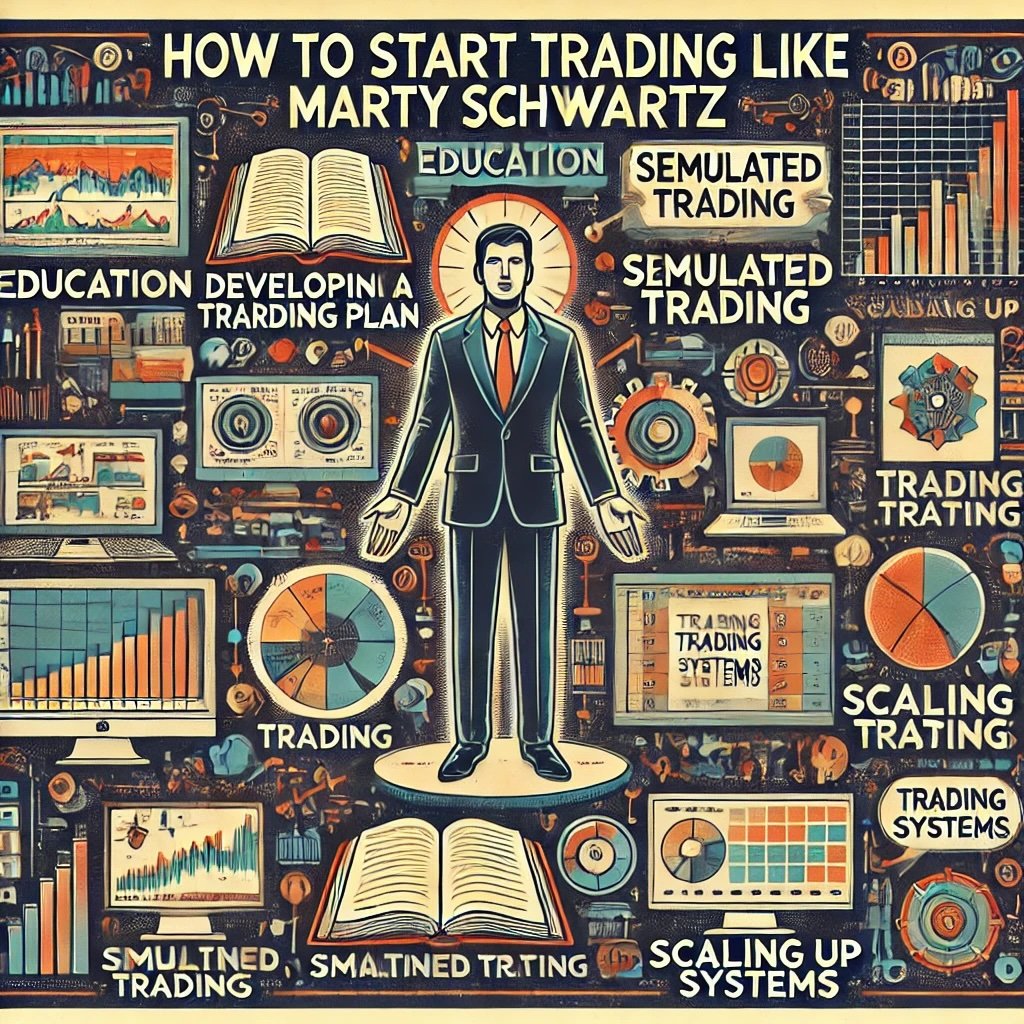Investing like Marty Schwartz means embracing short-term trading strategies, leveraging technical analysis, and maintaining disciplined risk management. Known as one of the most successful short-term traders of all time, Marty Schwartz, also known as “Pit Bull,” has left an indelible mark on the trading world. Whether you’re a novice investor or a seasoned trader, adopting Schwartz’s techniques can significantly enhance your trading approach. In this comprehensive guide, we’ll delve into Marty Schwartz’s trading philosophy, explore his core strategies, and provide actionable insights to help you emulate his success in short-term trading.
source: Financial Wizards on YouTube
Marty Schwartz: A Legend in Short-Term Trading
Marty Schwartz is a name that echoes through the corridors of trading history. Renowned for his exceptional success in short-term trading, Schwartz has inspired countless traders with his innovative strategies and unwavering discipline. His journey from a struggling analyst to a champion trader underscores the power of perseverance and strategic thinking in the financial markets.

Understanding Short-Term Trading
Short-term trading involves buying and selling financial instruments within a relatively brief period—ranging from minutes to weeks. Unlike long-term investing, which focuses on the appreciation of assets over years, short-term trading capitalizes on market volatility and quick price movements. This approach demands a keen eye for technical patterns, swift decision-making, and robust risk management.
We’ll attempt to explore Marty Schwartz’s trading strategies and techniques. By understanding his approach to short-term trading, investors can gain valuable insights into creating and implementing their own effective trading systems. From technical analysis to psychological discipline, we’ll cover the multifaceted aspects that make Marty Schwartz a standout figure in the trading world.

Who is Marty Schwartz?
Early Life and Background
Marty Schwartz’s journey into the world of trading is as fascinating as his trading successes. Born in New York City, Schwartz initially pursued a career in finance as an analyst. His early years were marked by a deep fascination with market dynamics and a relentless pursuit of understanding the intricacies of trading.
From Analyst to Champion Trader
Schwartz’s transition from a traditional finance role to becoming a short-term trading specialist was driven by his desire for more immediate and substantial returns. Dissatisfied with the slow pace of conventional investing, Schwartz sought ways to harness market volatility to his advantage. This led him to develop and refine short-term trading strategies that emphasized rapid decision-making and technical analysis.
Key Achievements
- U.S. Trading Championship Win: Marty Schwartz’s most notable achievement came in 1984 when he won the U.S. Trading Championship. His phenomenal performance, which saw him triple his investment within a year, solidified his reputation as a trading genius.
- Author and Educator: Beyond trading, Schwartz has contributed to the education of aspiring traders through books and seminars, sharing his knowledge and experiences to help others achieve success in short-term trading.
- Innovative Trading Systems: Schwartz is credited with pioneering several short-term trading techniques that have become staples in modern trading strategies.

Understanding Short-Term Trading
What is Short-Term Trading?
Short-term trading refers to strategies where traders buy and sell financial instruments within a short timeframe, often within the same day or over a few weeks. This approach contrasts with long-term investing, which focuses on holding assets for extended periods to benefit from long-term growth.
How Short-Term Trading Differs from Other Trading Styles
- Time Horizon: Short-term trading operates on minutes to weeks, whereas long-term investing spans years to decades.
- Strategy Focus: Short-term traders focus on technical analysis and market trends, while long-term investors rely more on fundamental analysis and intrinsic value.
- Risk and Reward: Short-term trading can offer higher returns due to frequent trades but also comes with increased risk and the need for rigorous risk management.
Why Marty Schwartz Focuses on Short-Term Strategies
Marty Schwartz gravitated towards short-term trading because of the opportunity to capitalize on market inefficiencies and volatility. He believed that by leveraging technical patterns and maintaining strict discipline, traders could consistently achieve superior returns. His focus on short-term strategies allowed him to maximize gains while minimizing exposure to prolonged market risks.
Market Conditions Favoring Short-Term Trading
Short-term trading thrives in volatile and liquid markets where price movements are frequent and significant. These conditions provide ample opportunities for traders to execute their strategies effectively. Key factors include:
- High Liquidity: Ensures that traders can enter and exit positions swiftly without significant price slippage.
- Market Volatility: Provides the price swings necessary for profitable trades.
- Active Trading Hours: Increases the frequency of trading opportunities.

Core Principles of Marty Schwartz’s Trading Strategy
Marty Schwartz’s trading success is anchored in several core principles that guide his decision-making and execution. These principles ensure that his trading remains disciplined, strategic, and resilient to market fluctuations.
1. Technical Analysis: Charts, Patterns, and Indicators
Technical analysis is the backbone of Schwartz’s trading strategy. He focuses on analyzing price charts, identifying patterns, and using technical indicators to make informed trading decisions.
Key Components of Schwartz’s Technical Analysis
- Price Charts: Schwartz meticulously studies various chart types (e.g., candlestick, bar charts) to discern market trends and patterns.
- Chart Patterns: He identifies patterns such as head and shoulders, double tops/bottoms, and triangles to predict future price movements.
- Technical Indicators: Utilizing indicators like Moving Averages, Relative Strength Index (RSI), and MACD helps Schwartz confirm trends and generate trade signals.
2. Risk Management: Limiting Losses and Preserving Capital
Effective risk management is crucial in short-term trading. Schwartz emphasizes the importance of protecting capital and minimizing losses to sustain long-term trading success.
Schwartz’s Risk Management Techniques
- Position Sizing: Determining the appropriate amount to invest in each trade based on the level of risk.
- Stop-Loss Orders: Setting predetermined exit points to limit potential losses on any given trade.
- Diversification: Spreading investments across various assets and markets to mitigate risk.
3. Discipline: Adhering to a Strict Trading Plan
Discipline is a cornerstone of Schwartz’s trading philosophy. He adheres strictly to his trading plan, ensuring that emotions do not interfere with his decision-making process.
Maintaining Discipline in Trading
- Predefined Rules: Schwartz’s trading decisions are based on clear, predefined rules that eliminate ambiguity.
- Routine and Consistency: Establishing a consistent trading routine helps reinforce disciplined behavior.
- Avoiding Overtrading: Limiting the number of trades to focus on high-conviction opportunities.
4. Market Timing: The Significance of Timing in Short-Term Trading
Market timing is critical in short-term trading. Schwartz places great emphasis on executing trades at the optimal moments to maximize returns and minimize risks.
Strategies for Effective Market Timing
- Entry and Exit Points: Identifying precise entry and exit points based on technical signals.
- Volume Analysis: Using trading volume as an indicator of trend strength and potential reversals.
- Economic Indicators: Monitoring economic news and data releases that can impact market movements.

Famous Trades and Market Calls
Marty Schwartz’s career is dotted with several notable trades that highlight the effectiveness of his short-term trading strategies. These trades not only showcase his ability to capitalize on market opportunities but also provide valuable lessons for aspiring traders.
1. The 1984 U.S. Trading Championship Win
One of Marty Schwartz’s most remarkable achievements was winning the 1984 U.S. Trading Championship. Under intense competition, Schwartz managed to triple his investment within a year, solidifying his reputation as a trading prodigy.
Strategy Behind the Win
- Aggressive Positioning: Schwartz took bold positions based on his technical analysis, identifying trends that others overlooked.
- Strict Risk Management: Despite the aggressive approach, he maintained strict risk controls to protect his capital.
- Emotional Discipline: By adhering to his trading plan, Schwartz avoided emotional pitfalls that could have derailed his performance.
Lessons Learned
- Confidence in Strategy: Believing in one’s trading system is crucial for success.
- Risk Control: Even aggressive strategies require robust risk management to prevent significant losses.
- Discipline: Sticking to a disciplined approach can lead to exceptional results, even under pressure.
2. Navigating the 1987 Stock Market Crash
During the 1987 stock market crash (Black Monday), many traders faced devastating losses. However, Schwartz’s systematic approach allowed him to navigate the volatile market successfully.
Strategy During the Crash
- Technical Signals: Schwartz’s algorithms identified key technical signals that indicated a market downturn.
- Quick Execution: His ability to execute trades swiftly helped him capitalize on the rapid price movements.
- Risk Mitigation: By employing stop-loss orders, he limited his exposure to significant losses.
Outcome and Impact
While the broader market suffered, Schwartz’s disciplined trading approach enabled him to protect his capital and even profit from the downturn. This event underscored the importance of technical analysis and risk management in short-term trading.
3. Profiting from the Dot-Com Bubble
In the late 1990s, the Dot-Com bubble saw unprecedented growth in internet-related stocks, followed by a sharp decline. Schwartz’s short-term trading strategies allowed him to profit from both the boom and the subsequent bust.
Strategy During the Bubble
- Trend Identification: Recognizing the strong upward trends in tech stocks, Schwartz took long positions to capitalize on the momentum.
- Reversal Signals: As the bubble showed signs of bursting, his technical indicators alerted him to exit positions and even take short positions to profit from the decline.
Outcome and Lessons
Schwartz’s ability to adapt to changing market conditions and his reliance on technical signals enabled him to maximize gains and minimize losses during the volatile period. This trade emphasized the importance of flexibility and systematic analysis in navigating market cycles.
Key Takeaways from Schwartz’s Famous Trades
- Adaptability: The ability to adjust strategies based on market conditions is vital for sustained success.
- Technical Proficiency: Mastery of technical analysis tools can provide a significant edge in identifying trading opportunities.
- Risk Management: Protecting capital through rigorous risk management is essential, especially during volatile periods.

Risk Management Techniques
Marty Schwartz’s Approach to Managing Risk
Risk management is the bedrock of Marty Schwartz’s trading philosophy. His meticulous approach ensures that his capital is protected, and potential losses are minimized, allowing for sustained trading success.
1. Volatility-Based Position Sizing
Position sizing is crucial in managing risk. Schwartz employs a volatility-based approach, adjusting the size of each trade based on the market’s volatility.
Key Strategies for Volatility-Based Position Sizing
- Average True Range (ATR): Utilizing the ATR to gauge market volatility and adjust position sizes accordingly.
- Dynamic Allocation: Increasing position sizes in less volatile markets and reducing them in more volatile ones to maintain consistent risk exposure.
- Proportional Risk: Ensuring that each trade risks a fixed percentage of the portfolio, regardless of market conditions.
2. Stop-Loss Orders: Limiting Potential Losses
Stop-loss orders are predefined exit points that limit potential losses on a trade. Schwartz integrates stop-loss orders into his trading system to ensure disciplined exits.
Implementing Stop-Loss Orders
- Technical Levels: Placing stop-loss orders at key support or resistance levels identified through technical analysis.
- Fixed vs. Trailing Stops: Using fixed stops for simplicity and trailing stops to lock in profits as the trade moves in a favorable direction.
- Automated Execution: Employing automated systems to execute stop-loss orders, ensuring timely exits without emotional interference.
3. Diversification: Spreading Risk Across Markets
Diversification involves spreading investments across various asset classes and markets to mitigate risk. Schwartz’s diversified approach enhances the resilience of his portfolio.
Seykota’s Diversification Strategies
- Asset Class Diversification: Investing in a mix of equities, bonds, commodities, and currencies to balance risk and return.
- Geographical Diversification: Allocating investments across different regions to reduce exposure to localized economic downturns.
- Sector Diversification: Spreading investments across various sectors to avoid concentration risk and capitalize on opportunities in different industries.
4. Balancing Risk and Reward
Balancing risk and reward is essential for optimizing portfolio performance. Schwartz’s approach ensures that each trade offers a favorable risk-reward ratio, enhancing the potential for sustained profitability.
Strategies for Balancing Risk and Reward
- Risk-Reward Ratio: Targeting trades where the potential reward significantly outweighs the risk, such as aiming for a 2:1 or 3:1 ratio.
- Thorough Analysis: Conducting comprehensive research and analysis to assess the viability and potential returns of each investment.
- Continuous Monitoring: Regularly reviewing and adjusting the portfolio to maintain an optimal balance between risk and reward, responding to changing market conditions.
Implementing Schwartz’s Risk Management Techniques
To effectively implement Schwartz’s risk management techniques, traders should:
- Define Risk Parameters: Clearly outline the maximum acceptable loss per trade and overall portfolio risk.
- Utilize Technology: Leverage trading platforms and software to automate risk management measures, ensuring consistent application.
- Regularly Review Strategies: Continuously assess and refine risk management strategies to adapt to evolving market dynamics.

The Role of Psychology in Short-Term Trading
Marty Schwartz’s Views on Trading Psychology
Marty Schwartz understands that psychology plays a pivotal role in trading, especially in the high-pressure environment of short-term trading. Maintaining emotional control and discipline is essential for executing strategies effectively and consistently.
Techniques for Maintaining Discipline and Emotional Control
1. Developing Emotional Resilience
- Mindfulness and Meditation: Engaging in mindfulness practices helps in maintaining focus and reducing stress, enabling traders to stay calm during volatile market conditions.
- Physical Fitness: Regular exercise contributes to overall mental well-being, enhancing emotional resilience and cognitive function.
- Continuous Learning: Staying informed and educated builds confidence and reduces anxiety, empowering traders to make informed decisions without fear.
2. Adhering to a Strict Trading Plan
- Predefined Rules: Schwartz’s trading decisions are based on clear, predefined rules that eliminate ambiguity and reduce the influence of emotions.
- Routine and Structure: Establishing a consistent trading routine reinforces disciplined behavior and minimizes the potential for impulsive decisions.
- Automated Trading Systems: Utilizing automated systems to execute trades based on predefined criteria helps in maintaining objectivity and reducing emotional interference.
The Impact of Psychology on Trading Performance and System Adherence
Psychological factors significantly influence trading performance and the ability to adhere to systematic strategies:
- Emotional Control: The ability to manage emotions like fear and greed ensures that trading decisions remain objective and consistent.
- Confidence: Building confidence through successful trades and thorough understanding of trading systems enhances performance.
- Stress Management: Effective stress management techniques prevent emotional burnout and maintain mental clarity during volatile market conditions.
Marty Schwartz’s Psychological Strategies
Schwartz employs several psychological strategies to maintain discipline and emotional resilience:
- Journaling: Keeping a trading journal to document trades, emotions, and reflections helps identify patterns and areas for improvement.
- Setting Realistic Goals: Establishing achievable trading goals maintains motivation and avoids undue pressure.
- Developing a Support System: Engaging with fellow traders, mentors, or support groups to share experiences and gain insights.
Importance of Mental Resilience in Executing Trades Effectively
Mental resilience enables traders to:
- Handle Losses: Accept and learn from losses without becoming discouraged or deviating from the trading system.
- Stay Focused: Maintain focus on long-term goals and strategies, even during periods of market turbulence.
- Adapt to Change: Remain adaptable and open to refining strategies based on new information and evolving market conditions.

Building a Short-Term Trading Strategy
Step-by-Step Guide to Developing a Short-Term Trading Strategy Inspired by Schwartz
Creating a robust short-term trading strategy requires a structured approach. Here’s a step-by-step guide inspired by Marty Schwartz’s methodologies:
1. Define Your Trading Goals
- Identify Objectives: Determine what you aim to achieve with your trading strategy, whether it’s capital growth, income generation, or risk mitigation.
- Set Time Horizons: Establish short-term and long-term goals to guide your trading activities.
2. Conduct Comprehensive Market Analysis
- Data Collection: Gather historical price data, economic indicators, and other relevant information.
- Trend Identification: Use statistical tools to identify trends and patterns in the data.
3. Develop Trading Rules and Algorithms
- Rule Creation: Define specific criteria for entering and exiting trades based on your analysis.
- Algorithm Development: Translate your trading rules into algorithms that can execute trades automatically.
4. Backtest Your Strategy
- Historical Testing: Apply your trading strategy to historical data to evaluate its performance.
- Performance Metrics: Analyze key metrics such as profitability, drawdowns, and risk-adjusted returns.
5. Optimize and Refine Your Strategy
- Parameter Tuning: Adjust the parameters of your trading rules and algorithms to enhance performance.
- Validation: Test the optimized strategy on out-of-sample data to ensure its robustness.
6. Implement Risk Management Techniques
- Position Sizing: Determine the appropriate size for each trade based on your risk tolerance.
- Stop-Loss Orders: Set predefined exit points to limit potential losses.
- Diversification: Spread investments across various markets and asset classes to mitigate risk.
7. Execute and Monitor Your Strategy
- Automated Execution: Utilize trading platforms that support automated trading to implement your strategy.
- Continuous Monitoring: Regularly review the performance of your trading system and make adjustments as needed.
Identifying and Analyzing Potential Trades
- Technical Signals: Use chart patterns and technical indicators to identify potential entry and exit points.
- Volume Analysis: Assess trading volume to confirm the strength of trends and potential reversals.
- Economic News: Monitor economic news and data releases that can impact market movements.
Tips for Refining and Adapting the Strategy Over Time
- Regular Reviews: Periodically assess your trading strategy’s performance and make necessary adjustments.
- Adapt to Market Changes: Be willing to modify your strategy in response to evolving market conditions and new information.
- Continuous Learning: Stay informed about new trading techniques, technologies, and market trends to enhance your strategy.
- Seek Feedback: Engage with other traders or mentors to gain insights and perspectives that can help refine your approach.
Sample Short-Term Trading Strategy Inspired by Schwartz
Here’s an example of a simple short-term trading strategy inspired by Marty Schwartz:
Strategy Overview
- Market: S&P 500 Index
- Time Frame: 5-minute charts
- Indicators: Moving Average Convergence Divergence (MACD), Relative Strength Index (RSI)
- Entry Rules:
- Long Position: Enter when the MACD crosses above the signal line and RSI is above 50.
- Short Position: Enter when the MACD crosses below the signal line and RSI is below 50.
- Exit Rules:
- Long Position Exit: Exit when MACD crosses below the signal line or RSI drops below 50.
- Short Position Exit: Exit when MACD crosses above the signal line or RSI rises above 50.
- Risk Management:
- Position Sizing: Allocate 1% of the portfolio to each trade.
- Stop-Loss: Set a stop-loss at 0.5% below the entry price for long positions and 0.5% above for short positions.
Implementation Steps
- Define Trading Rules: Clearly outline the conditions for entering and exiting trades based on MACD and RSI signals.
- Develop Algorithm: Program the rules into a trading platform that supports automated trading.
- Backtest: Apply the strategy to historical S&P 500 data to evaluate its performance.
- Optimize: Adjust the indicator parameters or risk management rules to enhance profitability and reduce drawdowns.
- Forward Test: Implement the strategy in a simulated trading environment to observe real-time performance.
- Execute: Deploy the strategy in a live trading account with proper risk management measures in place.
- Monitor and Refine: Continuously track the strategy’s performance and make adjustments as necessary.

Challenges of Short-Term Trading
Potential Pitfalls and Difficulties in Adopting a Short-Term Approach
While short-term trading offers significant opportunities, it also comes with its share of challenges. Understanding and addressing these pitfalls is crucial for achieving long-term success.
1. High Volatility and Rapid Market Changes
Short-term trading thrives on market volatility, but excessive volatility can lead to rapid losses if not managed properly.
- Risk: Sudden price swings can trigger stop-loss orders, resulting in losses.
- Solution: Implement robust risk management techniques, such as volatility-based position sizing and diversified trading strategies.
2. Emotional Strain and Stress
The fast-paced nature of short-term trading can be emotionally taxing, leading to stress and burnout.
- Risk: Emotional decision-making can result in impulsive trades and deviations from the trading plan.
- Solution: Maintain discipline by adhering strictly to the trading plan, and incorporate stress management techniques like mindfulness and regular breaks.
3. Overtrading and Transaction Costs
Frequent trading can lead to overtrading, increasing transaction costs and eroding profits.
- Risk: High transaction costs can significantly reduce overall profitability.
- Solution: Focus on high-conviction trades and optimize the trading strategy to minimize unnecessary trades.
4. Information Overload
Short-term traders must process vast amounts of information quickly, which can be overwhelming.
- Risk: Difficulty in filtering relevant information can lead to analysis paralysis or missed opportunities.
- Solution: Utilize automated trading systems to handle data analysis and execute trades, allowing traders to focus on strategy refinement.
How to Overcome Common Challenges in Day Trading and Swing Trading
1. Robust Risk Management
Implement comprehensive risk management strategies to protect capital and minimize losses.
- Position Sizing: Allocate a fixed percentage of the portfolio to each trade based on risk tolerance.
- Stop-Loss Orders: Set predefined exit points to limit potential losses.
- Diversification: Spread investments across various assets to mitigate risk.
2. Emotional Discipline
Cultivate emotional resilience to maintain focus and discipline during trading.
- Mindfulness Practices: Engage in activities like meditation to enhance emotional control.
- Trading Journal: Keep a record of trades and emotions to identify patterns and areas for improvement.
- Set Realistic Goals: Establish achievable trading goals to maintain motivation and avoid undue pressure.
3. Continuous Learning and Adaptation
Stay informed and adapt trading strategies based on evolving market conditions.
- Stay Updated: Regularly follow financial news, economic indicators, and market analyses.
- Refine Strategies: Continuously evaluate and adjust trading strategies to align with current market dynamics.
- Seek Feedback: Engage with other traders or mentors to gain insights and refine approaches.
4. Utilize Technology and Tools
Leverage advanced trading platforms and analytical tools to enhance trading efficiency.
- Automated Trading Systems: Use algorithms to execute trades based on predefined rules, reducing emotional interference.
- Analytical Software: Utilize tools like TradingView or MetaTrader for technical analysis and strategy development.
- Data Sources: Access reliable data sources like Bloomberg or Quandl to inform trading decisions.
The Importance of Staying Informed and Adaptable in Fast-Moving Markets
In the dynamic world of short-term trading, staying informed and adaptable is essential for maintaining a competitive edge. Traders must continuously monitor market conditions, economic indicators, and geopolitical events that can influence price movements. Being adaptable allows traders to modify their strategies in response to new information, ensuring sustained effectiveness and profitability.

How to Start Trading Like Marty Schwartz
Practical Steps for Implementing Schwartz’s Strategies in Your Own Trading
Emulating Marty Schwartz’s short-term trading approach involves a structured and disciplined process. Here are practical steps to help you get started:
1. Educate Yourself in Short-Term Trading
- Foundational Knowledge: Gain a solid understanding of short-term trading principles, technical analysis, and trading psychology.
- Advanced Studies: Pursue advanced courses or certifications in trading strategies, market analysis, and risk management.
2. Develop a Comprehensive Trading Plan
- Define Objectives: Clearly outline your trading goals, including desired returns, risk tolerance, and investment horizon.
- Strategy Formulation: Develop trading strategies based on technical analysis, risk management, and market timing principles.
- Risk Management Protocols: Establish rules for position sizing, stop-loss orders, and portfolio diversification to protect your capital.
3. Start with a Simulated Trading Environment
- Paper Trading: Begin by executing your trading strategies in a simulated environment to gain experience without risking real capital.
- Backtesting: Apply your strategies to historical data to evaluate their performance and identify areas for improvement.
4. Gradually Scale Up Your Trading Activities
- Small Positions: Start with small positions to test your strategies in live market conditions without exposing yourself to significant risk.
- Incremental Scaling: Gradually increase your position sizes as you gain confidence and experience in your trading strategies.
5. Implement Automated Trading Systems
- Algorithm Development: Translate your trading rules into algorithms that can execute trades automatically based on predefined criteria.
- Platform Selection: Choose reliable trading platforms that support automated trading and offer robust analytical tools.
6. Monitor and Refine Your Trading Systems
- Performance Tracking: Continuously monitor the performance of your trading systems using key metrics such as profitability, drawdown, and risk-adjusted returns.
- System Refinement: Regularly update and optimize your trading systems based on performance data and changing market conditions.
Resources for Further Learning About Short-Term Trading Techniques
To deepen your understanding of short-term trading and enhance your trading skills, consider the following resources:
Books
- Market Wizards by Jack D. Schwager
- Reminiscences of a Stock Operator by Edwin Lefèvre
- The New Trading for a Living by Dr. Alexander Elder
- Technical Analysis of the Financial Markets by John J. Murphy
Online Courses
- Coursera’s Financial Markets: Offers comprehensive insights into financial markets and trading strategies.
- Udemy’s Day Trading and Swing Trading Strategies for Stocks: Provides detailed strategies and techniques for short-term trading.
- edX’s Introduction to Computational Thinking and Data Science: Enhances your ability to develop algorithmic trading strategies.
Websites and Journals
- Investopedia: Features a wealth of articles and tutorials on short-term trading and technical analysis.
- TradingView: Offers powerful charting tools, a vibrant community of traders, and educational resources.
- The Journal of Portfolio Management: Provides in-depth research and analysis on trading strategies and portfolio management.
Tools and Platforms to Support Short-Term Trading Activities
Leveraging the right tools and platforms is essential for developing, testing, and executing short-term trading strategies. Here are some recommended options:
Trading Platforms
- MetaTrader 4/5: Offers advanced charting capabilities, automated trading features, and a user-friendly interface.
- Thinkorswim by TD Ameritrade: Provides comprehensive trading tools, real-time data, and support for automated trading strategies.
- Interactive Brokers’ Trader Workstation (TWS): Known for its extensive range of tradable assets, low commission rates, and robust trading tools.
Analytical Tools
- TradingView: Offers powerful charting tools, a vibrant community of traders, and the ability to backtest trading strategies.
- Bloomberg Terminal: Delivers in-depth financial data, analytics, and trading tools for professional traders.
- NinjaTrader: Provides advanced charting, market analytics, and automated trading capabilities.
Data Sources
- Yahoo Finance: A free resource for historical price data and financial news.
- Quandl: Offers access to a vast array of financial, economic, and alternative datasets for quantitative analysis.
- Bloomberg: Provides comprehensive financial data and market analytics.
Building Analytical Skills for Short-Term Trading
Developing strong analytical skills is crucial for designing and implementing effective short-term trading strategies. Focus on the following areas:
1. Technical Analysis
- Chart Patterns: Learn to identify and interpret chart patterns like head and shoulders, double tops/bottoms, and triangles.
- Technical Indicators: Master the use of indicators such as Moving Averages, RSI, MACD, and Bollinger Bands to inform trading decisions.
2. Data Analysis
- Statistical Methods: Develop a strong grasp of statistical concepts like regression analysis, hypothesis testing, and probability distributions.
- Programming Skills: Learn programming languages like Python or R to develop and implement trading algorithms.
3. Market Research
- Economic Indicators: Understand how macroeconomic indicators like GDP, inflation, and unemployment rates influence market movements.
- Market Sentiment: Assess investor sentiment and its impact on market trends through tools like sentiment analysis and social media monitoring.
4. Risk Assessment
- Volatility Analysis: Utilize tools like the Average True Range (ATR) to measure market volatility and inform risk management decisions.
- Correlation Analysis: Understand the relationships between different assets to optimize portfolio diversification and minimize risk.
Marty Schwartz (“Pit Bull”): 12-Question FAQ
Who is Marty Schwartz and why is he influential?
A champion short-term trader (nicknamed “Pit Bull”), known for aggressive but disciplined tactics, precise technical timing, and rigorous risk control that turned small capital into outsized returns.
What does “short-term trading” mean in Schwartz’s playbook?
Capturing moves that unfold over minutes to days/weeks (day & swing trades), prioritizing liquidity, volatility, and repeatable chart/indicator signals over long-horizon fundamentals.
What are his core principles?
Trade the tape, not opinions; define the trend first; only take high-probability, well-defined setups; use hard stops; size small enough to think clearly; and review your process daily.
Which technical tools does he lean on?
Trend and momentum staples—moving averages, price/volume patterns, RSI/MACD, breakouts/retests, and market internals (e.g., breadth/ticks) to confirm thrust and avoid fading strength.
How does he time entries and exits?
Enter on clean breakouts/pullback retests aligned with the prevailing trend; exit on stop breaches, failure retests, momentum rollovers, or when targets/ATR-based trails are hit.
What does risk management look like for him?
Tight per-trade risk (often well under 1–2% of equity), hard stops placed where the setup is invalid, and portfolio “heat” caps so several small losses can’t become a large one.
How are position size and stops set?
Size from volatility and distance to the invalidation level (e.g., ATR or structural swing), not from desired P&L; stops go beyond noise (below/above structure) and are never widened.
Day trading vs. swing trading—how does he choose?
Day trades around intraday momentum/levels when volatility and liquidity are high; swing trades when a daily trend shows follow-through with tight, repeatable pullback entries.
How does he avoid overtrading?
A pre-defined playbook, A-/B-/C-setup tiers, limits on trades per session, and “no signal, no trade” rules—standing down is a skill, not a weakness.
What role does psychology play?
Huge. He emphasizes routines, journaling, breathing/pauses after losses, and the humility to admit when the market disagrees—discipline beats genius in the short run.
Common mistakes to avoid?
Chasing moves, averaging losers, moving stops, oversizing in choppy regimes, trading during major news without a plan, and letting one theme dominate your risk.
How can a retail trader apply his methods today?
Build a simple ruleset (trend filter + setup + stop + target), backtest it, start tiny, automate alerts, review daily with screenshots, and scale only when execution is consistent.

Key Takeaways from Marty Schwartz’s Trading Approach
Marty Schwartz’s short-term trading approach offers a robust framework for achieving consistent success in the financial markets. Here are the key takeaways from his trading philosophy:
- Technical Mastery: Emphasize technical analysis to identify and capitalize on market trends and patterns.
- Rigorous Risk Management: Prioritize capital preservation through disciplined risk management techniques, including position sizing, stop-loss orders, and diversification.
- Emotional Discipline: Maintain emotional control and stick to the trading plan to ensure consistent performance.
- Market Timing: Execute trades at optimal moments to maximize returns and minimize risks.
- Continuous Learning: Commit to ongoing education and strategy refinement to adapt to evolving market conditions.
- Systematic Execution: Utilize automated trading systems to execute trades based on predefined rules, reducing the influence of emotions and enhancing consistency.
Relevance of Short-Term Trading in Today’s Markets
Short-term trading remains highly relevant in today’s dynamic and fast-paced financial markets. With the advent of advanced technologies, high-frequency trading, and the availability of vast amounts of data, short-term trading offers traders numerous opportunities to capitalize on market inefficiencies and volatility. Marty Schwartz’s pioneering work in short-term trading underscores the importance of technical analysis, risk management, and psychological discipline in achieving sustained trading success.
Explore and Experiment with These Strategies
Embarking on a short-term trading journey inspired by Marty Schwartz is both challenging and rewarding. It requires a commitment to discipline, continuous learning, and the ability to adapt to changing market conditions. However, the potential rewards—consistent profitability, reduced emotional stress, and scalable trading operations—make it a compelling approach for dedicated traders.
As you explore and develop your own trading systems, remember to:
- Stay Disciplined: Adhere strictly to your trading rules and risk management protocols.
- Be Patient: Short-term trading often involves waiting for the right market conditions and opportunities.
- Embrace Technology: Leverage advanced trading platforms and analytical tools to enhance your trading capabilities.
- Continuously Refine: Regularly review and optimize your trading systems to ensure they remain effective and aligned with your trading goals.
- Learn from Mistakes: Analyze your trading performance to identify and rectify errors, fostering continuous improvement.
By embracing the principles and strategies of Marty Schwartz, you can navigate the complexities of financial markets with confidence and strategic insight. Short-term trading offers a pathway to disciplined, consistent, and potentially lucrative trading, embodying the essence of Marty Schwartz’s enduring legacy in the world of finance.
Investing like Marty Schwartz isn’t just about following a set of rules; it’s about cultivating a mindset that prioritizes technical mastery, disciplined risk management, and continuous improvement. By embracing short-term trading principles, you can navigate the financial markets with precision and confidence, unlocking the potential for sustained trading success. Happy trading!
Important Information
Comprehensive Investment Disclaimer:
All content provided on this website (including but not limited to portfolio ideas, fund analyses, investment strategies, commentary on market conditions, and discussions regarding leverage) is strictly for educational, informational, and illustrative purposes only. The information does not constitute financial, investment, tax, accounting, or legal advice. Opinions, strategies, and ideas presented herein represent personal perspectives, are based on independent research and publicly available information, and do not necessarily reflect the views or official positions of any third-party organizations, institutions, or affiliates.
Investing in financial markets inherently carries substantial risks, including but not limited to market volatility, economic uncertainties, geopolitical developments, and liquidity risks. You must be fully aware that there is always the potential for partial or total loss of your principal investment. Additionally, the use of leverage or leveraged financial products significantly increases risk exposure by amplifying both potential gains and potential losses, and thus is not appropriate or advisable for all investors. Using leverage may result in losing more than your initial invested capital, incurring margin calls, experiencing substantial interest costs, or suffering severe financial distress.
Past performance indicators, including historical data, backtesting results, and hypothetical scenarios, should never be viewed as guarantees or reliable predictions of future performance. Any examples provided are purely hypothetical and intended only for illustration purposes. Performance benchmarks, such as market indexes mentioned on this site, are theoretical and are not directly investable. While diligent efforts are made to provide accurate and current information, “Picture Perfect Portfolios” does not warrant, represent, or guarantee the accuracy, completeness, or timeliness of any information provided. Errors, inaccuracies, or outdated information may exist.
Users of this website are strongly encouraged to independently verify all information, conduct comprehensive research and due diligence, and engage with qualified financial, investment, tax, or legal professionals before making any investment or financial decisions. The responsibility for making informed investment decisions rests entirely with the individual. “Picture Perfect Portfolios” explicitly disclaims all liability for any direct, indirect, incidental, special, consequential, or other losses or damages incurred, financial or otherwise, arising out of reliance upon, or use of, any content or information presented on this website.
By accessing, reading, and utilizing the content on this website, you expressly acknowledge, understand, accept, and agree to abide by these terms and conditions. Please consult the full and detailed disclaimer available elsewhere on this website for further clarification and additional important disclosures. Read the complete disclaimer here.




